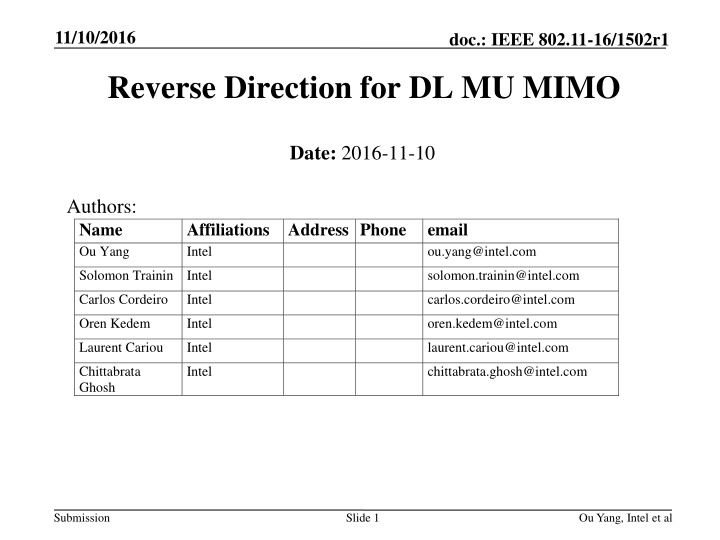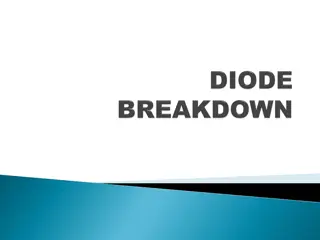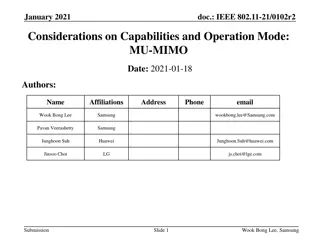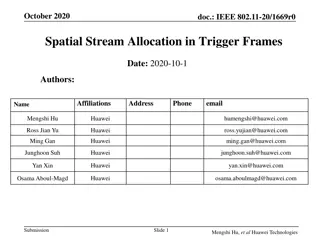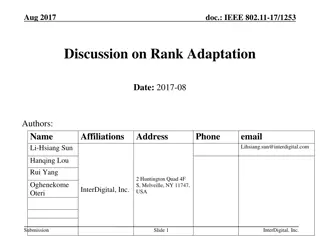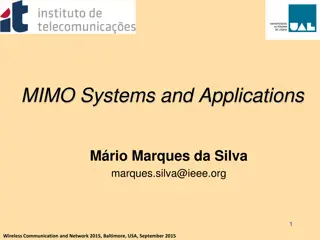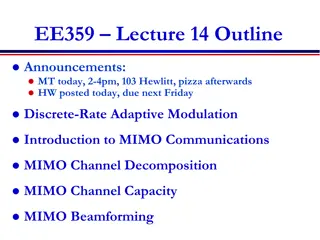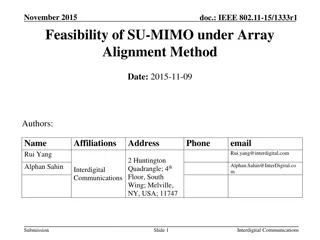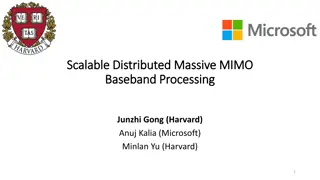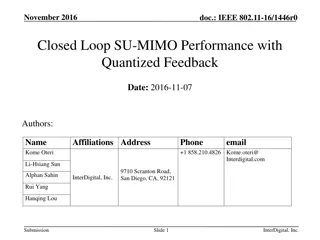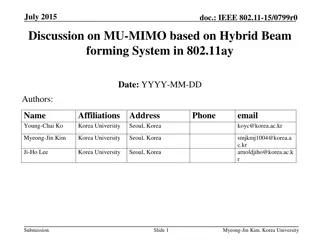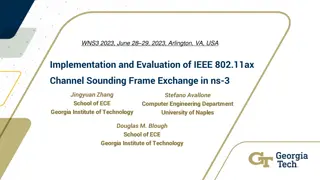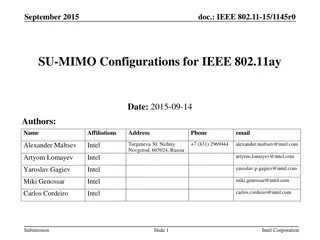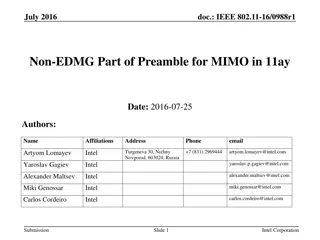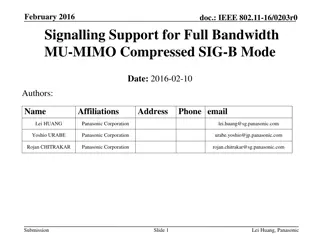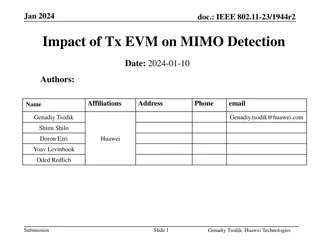IEEE 802.11-16/1502r1 Reverse Direction for DL MU MIMO
In this document dated 11/10/2016, the IEEE 802.11-16/1502r1 standard explores the motivation behind Reverse Direction for Downlink Multi-User Multiple Input Multiple Output (DL MU MIMO). The goal is to define the behavior of Reverse Direction for DL MU MIMO in the context of existing protocols such as BlockACK in 11ac and SISO in 11ad. The document discusses how Reverse Direction can enhance UL channel access, TCP throughput, and user experience for applications with strict delay requirements, aiming to minimize changes to existing protocols. Various authors from Intel collaborate on presenting this insightful content.
Download Presentation

Please find below an Image/Link to download the presentation.
The content on the website is provided AS IS for your information and personal use only. It may not be sold, licensed, or shared on other websites without obtaining consent from the author.If you encounter any issues during the download, it is possible that the publisher has removed the file from their server.
You are allowed to download the files provided on this website for personal or commercial use, subject to the condition that they are used lawfully. All files are the property of their respective owners.
The content on the website is provided AS IS for your information and personal use only. It may not be sold, licensed, or shared on other websites without obtaining consent from the author.
E N D
Presentation Transcript
11/10/2016 doc.: IEEE 802.11-16/1502r1 Reverse Direction for DL MU MIMO Date: 2016-11-10 Authors: Name Ou Yang Affiliations Address Phone Intel email ou.yang@intel.com Solomon Trainin Intel solomon.trainin@intel.com Carlos Cordeiro Intel carlos.cordeiro@intel.com Oren Kedem Intel oren.kedem@intel.com Laurent Cariou Intel laurent.cariou@intel.com Chittabrata Ghosh Intel chittabrata.ghosh@intel.com Submission Slide 1 Ou Yang, Intel et al
11/10/2016 doc.: IEEE 802.11-16/1502r1 Motivation Reverse Direction (RD) for SISO transmissions is defined in 11ad RD for DL MU-MIMO - provides efficient UL channel access - may improve TCP throughput - may improve user experience for applications with tight delay constraints How to support RD for DL MU-MIMO has not yet been defined Submission Slide 2 Ou Yang, Intel et al
11/10/2016 doc.: IEEE 802.11-16/1502r1 BlockACK and RD for DL MU-MIMO RD is a natural extension of BlockACK - RD behavior depends on BlockACK mechanism for DL MU- MIMO Related work - BlockACK for DL MU-MIMO is defined in 11ac - RD is defined for SISO in 11ad Goal - define RD behavior for DL MU-MIMO for 11ay - minimize changes introduced to 11ac BlockACK and 11ad RD protocols Submission Slide 3 Ou Yang, Intel et al
11/10/2016 doc.: IEEE 802.11-16/1502r1 BlockACK for MU MIMO in 11ac AP sends out one MU PPDU to the group. One of the STA (STA1 in the example) sends immediate BlockACK AP sends BlockACKReq to one of the STAs whose BlockACK has not been collected (STA2 in the example) The STA that receives the BlockACKReq responds with its BlockACK AP continues to sends BlockACKReq to one of the STAs whose BlockACK has not been collected if any AP sends the next MU PPDU Submission Slide 4 Ou Yang, Intel et al
11/10/2016 doc.: IEEE 802.11-16/1502r1 RD Behavior in 11ad Step 1: RD initiator - set RDG = 1 in QoS Control field of the MPDU Step 2: RD responder - sends BACK or ACK SIFS after RD grant - BACK or ACK can be aggregated with DATA - PPDUs in RD response burst can be SIFS or RIFS apart - last PPDU in RD response burst has RDG/MorePPDU = 0, it may expect response - other PPDUs in RD response burst has RDG/MorePPDU = 1, no response expected Step 3: RD initiator - sends next PPDU SIFS after successfully receives RD response burst - next PPDU may piggyback BACK or ACK (if needed by RD responder) Submission Slide 5 Ou Yang, Intel et al
11/10/2016 doc.: IEEE 802.11-16/1502r1 Solution: RD for DL MU-MIMO (1) Step 1: RD initiator indicates RD grant to a specific STA AP/PCP grants RD to the STA that sends immediate BACK after MU MIMO PPDU - set RDG/MorePPDU = 1 and ACK Policy = 0 0 AP/PCP grants RD to the STA that is polled by BlockAckReq for BACK - aggregate BAR with QoS Null - QoS Null has RDG/MorePPDU = 1 Submission Slide 6 Ou Yang, Intel et al
11/10/2016 doc.: IEEE 802.11-16/1502r1 Solution: RD for DL MU-MIMO (2) Step 2: RD responder utilizes RD grant RD responder sends RD response burst with single PPDU - BACK, or - AMPDU (BACK + QoS DATA with RDG/MorePPDU = 0), or - AMPDU (BACK + QoS Null with RDG/MorePPDU = 0) RD responder sends RD response burst with multiple PPDUs - first AMPDU (BACK + QoS DATA with RDG/MorePPDU = 1) - following PPDUs (QoS DATA with RDG/MorePPDU = 1) - last PPDU (QoS DATA with RDG/MorePPDU = 0) Submission Slide 7 Ou Yang, Intel et al
3/21/2025 doc.: IEEE 802.11-16/1502r1 Solution: RD for DL MU MIMO (3) Step 3: RD initiator responds to RD response burst If BACK is not required, RD initiator continues with sending - next BAR, or - next MU PPDU If BACK is required by the RD responder, RD initiator sends BACK to RD responder - along with the next BAR in MU MIMO fashion, or - along with AMPDU (BACK + QoS DATA) to the RD responder in the next MU PPDU Submission Slide 8 Ou Yang, Intel et al
11/10/2016 doc.: IEEE 802.11-16/1502r1 Conclusion We recommend to enable RD for DL MU MIMO to improve UL channel access efficiency RD solution for DL MU MIMO - Reuse BlockACK protocol for MU MIMO in 11ac - Reuse RD protocol for SISO in 11ad - Flexibility to enable RD for arbitrary number of STAs per MU PPDU Submission Slide 9 Ou Yang, Intel et al
3/21/2025 doc.: IEEE 802.11-16/1502r1 Straw Poll Do you agree to insert the following sentence in the SFD that the reverse direction protocol shall be extended to support DL MU- MIMO? Do you agree to insert the following sentence in the SFD that 11ay shall adopt the BlockACK mechanism defined in 11ac for DL MU- MIMO? Do you agree to insert the following sentence in the SFD that DL MU- MIMO transmission shall support RD accordingly to the rules described in slide 6, 7 and 8? Submission Slide 10 Ou Yang, Intel et al
